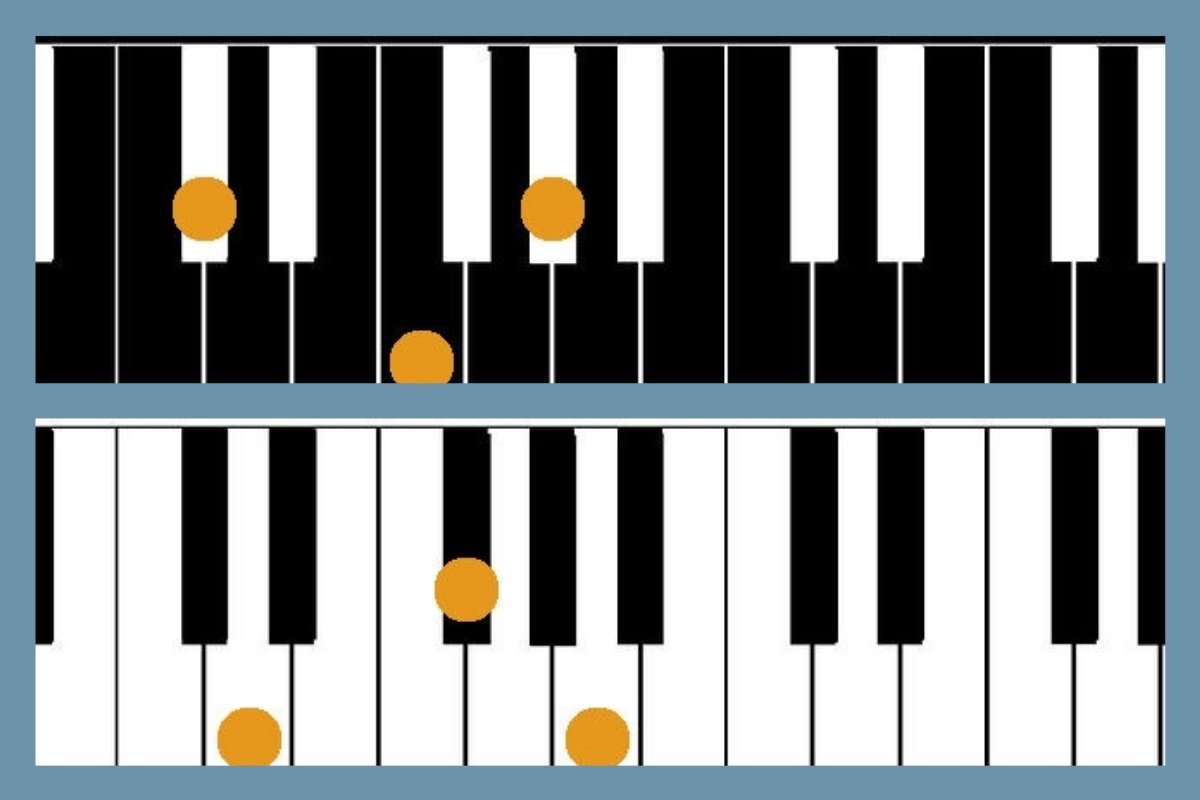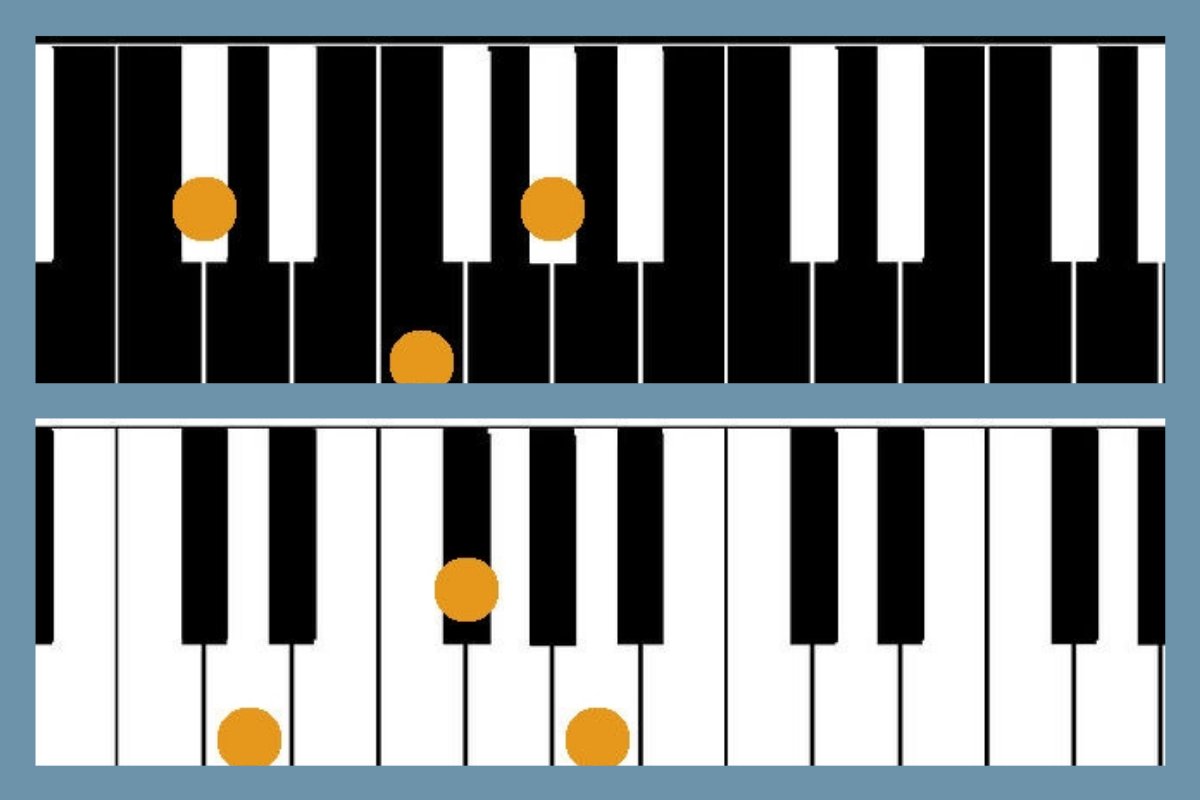Learning chords on the piano is not difficult, but we can use different techniques and different ways of thinking. In this lesson I propose a simple and effective system for learning and remembering chords on the piano, we’ll call this system the photo negative technique. We will also see how to perform chord arpeggios and you can download the .pdf with the correct fingerings.
Learning to recognise and form chords on the piano keyboard is easier than on any other instrument. That’s why even those who don’t play the piano should have a keyboard at home and use it to study the elementary concepts of harmony, starting with chords. Let’s take a look at some ways of learning chord notes.
There is no single system for learning chords on the piano. Let’s take a look at the main ones so that you can use the one that is easiest for you. In particular, we will see how to find chords in three ways:
Piano chords: getting the chord from the scale
The first system is to find chords on the major scale. If we harmonize the major scale, it means that on each note of the scale we take three notes: the first, the third and the fifth note.
On the first degree of a major scale we find a major chord, for example, on the first note of the C scale we find the major chord C E G. On the second degree of a major scale, we find a minor chord. For example, on the C major scale, the second note is D, and the D F A chord is a minor chord.
Deriving chord notes from the key scale is the most correct system because it maintains the relationship between scale and chord, a relationship that is very important in music. However, this method is also the most difficult, because it requires knowledge of major and minor scales. Let’s look at a second system for learning chords on the piano.
Count tones and semitones to find the notes of the chord
In the musical system of European origin called the tonal system, there are twelve different tonalities, one for each musical note (including sharps and flats). Thankfully, what happens in one key is repeated in all other keys.
For example, the major scale consists of a starting note (called the tonic) and a series of intervals that are always equal. The complete formula is: tonic tone tone semitone tone tone tone semitone.
Chords are also formed with the same distances between the notes, in each key. Major chords are formed by the starting note (called the tonic), an interval of two tones, an interval of a tone and a half. The minor chord has the same intervals but reversed: tonic, one and a half tones, two tones.
Major chord: Tonic + two tones + one and a half tones
Minor chord: Tonic + a tone and a half + two tones
Calculating major and minor chords with this system is quicker and easier, especially if you don’t yet know the major and minor scales (but you will have to learn them sooner or later!).
However, calculating tones and semitones on the keyboard always takes a few moments, so to memorize major and minor chords on the piano there is perhaps an even more effective system, which we call the photo negative technique.
Finding chords on the piano keyboard with white keys and black keys
This system is used to remember piano chords by their shape on the keyboard and by the position the hand takes when playing them.
Learning chords in this way is easier because it involves three different levels of memory: mathematical memory (the distance between sounds), visual memory (the colour of the keys) and movement memory (the shape of the chord under the hand). This is how the photographic negative method for learning chords on the piano works.
We divide the chords into three groups. The chords in the first group consist only of white keys, and are the chords of C, F, G major. It is easy to remember them by looking at the keyboard, just by skipping a white key. Let’s take the C major chord as an example:

F and G chords have the same shape. Of course, the F chord starts with F, the G chord starts with G. But the key sequence (three white keys) and the hand position are exactly the same.
The chords in the second group are similar, but use a black key in the middle and two white keys on either side. This is how the D, E and A chords are formed.

We have thus learned six chords built on the white keys of the piano. The last one that remains to be learned corresponds to the last note of the scale: B. The B chord is formed using two black keys, D# and F#.

Starting from these three groups of chords, we can derive the chords built on the black keys, imagining that they are the inverse of those from which they derive. We are talking about the keys with flat notes: D♭, E♭, G♭, A♭ and B♭.
Each of these chords has a shape that is exactly the inverse of the one built on the adjacent white key. This is why we think of an old photographic film negative, where light and dark appear to be the inverse of what is then visible in the photo.
D major is made up of two white keys at the ends and a black key in the middle: D♭ is exactly the reverse, two black keys at the ends and a white one in the middle.

The same applies to the E♭ and A♭ chords. The G♭ chord is made up of three black keys, the inverse of natural G (three white keys).

Finally, the B♭ chord (one black key, two white keys) is the inverse of the B chord (one white key, two black keys), like this:

How to learn and memorise chords on the piano
If you don’t know the chords on the piano at all, you can try to learn them in this order:
- Learn C, F, G major chords
- Learn chords of D, E, A major
- Learn B major chord
- Learn chords formed on the black keys, using the photo negative system
Learn to play minor chords
Minor chords can also be divided into three groups.
- Group 1, white keys only: Am, Dm, Em
- Group 2, one black middle key: Cm, Fm, Gm
- Group 3, one black end key: Bm
We will then find the chords on the black keys, using the photo negative technique:
- Chords of C#m, F#m, G#m: two black keys on the sides and a white one in the middle (the inverse of Cm, Fm, Gm)
- E♭m chord, three black keys (the inverse of Em, three white keys)
- B♭m chords, two black keys and one white key (the inverse of Bm, two white and one black)
If, in addition to knowing the chords, you want to learn the abbreviations with which they are written, especially in the pop and jazz repertoire, you might be interested in the lesson on how to read the chord symbols.
Chord arpeggios on the piano, fingerings and .pdf
Knowing how to play major and minor chord arpeggios is essential if you want to play pop, rock and jazz on piano and keyboards. This exercise is also particularly useful from a technical point of view, as it includes two very important movements: the thumb pass and the wrist rotation.
Next are the fingerings of all the arpeggios of the triads over an octave. In this exercise we play the three notes of the triad and the doubling of the root note an octave above the starting note, as in the following example:

Watch the video tutorial to learn chord arpeggios on the piano.
Arpeggio fingering for the right hand
The arpeggio starts with the first finger when the chord is built on a white key and for G♭ and E♭m chords. In other cases, the fingering is different, to avoid using the first finger on a black key, which is very uncomfortable since the thumb is the shortest finger.
The same can be said of the 5th finger, the little finger. The following fingerings therefore respect this principle: avoid using fingers 1 and 5 on the black keys. Playing chord arpeggios is much easier if we use the longest fingers on the black keys: 2nd, 3rd and 4th fingers.
| Fingerings | Major chords | Minor chords |
|---|---|---|
| 123 321 1 | C, G, D, A, E, B, G♭, F | Cm, Gm, Dm, Am, Em, Bm, E♭m, Fm |
| 212 421 2 | B♭, E♭, A♭, D♭ | F#m, C#m, G#m |
| 231 313 2 | B♭m |
Left hand fingering
Below are the fingerings for arpeggios for the left hand. When accompanying a song, it is often the case that the left hand plays arpeggios in the middle of the keyboard, so it is important to learn the correct fingerings from the very beginning.
| Fingerings | Major chords | Minor chords |
| 542 124 5 | C, G, F, G♭ | Cm, Gm, Dm, Am, Em, Bm, E♭m, Fm |
| 532 123 5 | D, A, E, B | |
| 214 241 2 | D♭, A♭, E♭ | F#m, C#m, G#m |
| 421 212 4 | B♭ | B♭m |
Chord arpeggios on the piano, with two hands
Once you have learned the arpeggios with separate hands, try playing them with both hands. This will not be easy at first, as the fingerings of the two hands are not symmetrical.
Useful resources
Final remarks, what chords are used for
Knowing how to form chords on the piano and how to play arpeggios is very important for playing modern music, songs and even jazz repertoire.
If you would like to learn more about this subject, please see the functional harmony course and the modern piano course on this website. If, on the other hand, you don’t quite understand how piano chords work, or if you have any questions or comments about this lesson, please write them in the comments below. Thank you!



Thank you for sharing this. It is really helpful.
You’re welcome, thanks for you comment.